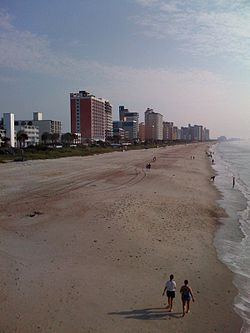User:Crtrue/MBTest
City of Myrtle Beach | |
|---|---|
 Oceanfront alongside Ocean Boulevard | |
 Location of Myrtle Beach in South Carolina | |
| Country | United States |
| State | South Carolina |
| County | Horry |
| Government | |
| • Mayor | John Rhodes (R) |
| Area | |
| • City | 16.8 sq mi (43.5 km2) |
| • Land | 16.8 sq mi (43.5 km2) |
| • Water | 12,359,674 sq mi (0.1 km2) |
| Elevation | 26 ft (8 m) |
| Population (2009) | |
| • City | 31,968 |
| • Density | 1,356/sq mi (523.7/km2) |
| • Metro | 324,571 |
| Time zone | UTC-5 (EST) |
| • Summer (DST) | UTC-4 (EDT) |
| ZIP Codes | 29572, 29575, 29577, 29578, 29579, 29587, 29588 |
| Area code | 843 |
| FIPS code | 45-49075Template:GR |
| GNIS feature ID | 1249770Template:GR |
| Website | www.cityofmyrtlebeach.com |
Myrtle Beach (/[invalid input: 'icon']mʊrˈtəlˈbiːtʃ/ is a city on the coast of Horry County, South Carolina, located on the Atlantic coastal plain south of North Carolina's Southern Outer Banks. It is situated near the center of large and continuous stretch of beach known as the Grand Strand and is a major tourist destination in the Southeast, attracting an estimated 14.6 million visitors each summer.
Geography

Landform
Technically a man-made island, Myrtle Beach has been separated from the continental United States since 1936 by the Intracoastal Waterway[1], forcing the city and area in general to develop within a small distance from the coast. In part due to this separation, the area directly west of Myrtle Beach across the waterway remains primarily rural, whereas its northern and southern ends are bordered by other developed tourist towns, North Myrtle Beach and Surfside Beach.
Due to strong erosion along the Atlantic Ocean, the city is separated from its beach by large dunes populated with sea grasses, which stabilize the sandy soil underneath and act as a natural seawall against storm surge. In conjunction, the city has also renourished the beach's sands several times, with one instance almost immediately followed by the landfall of Hurricane Hugo, necessitating a second replenishment to fill in the quick loss of the first.
Climate
According to Köppen climate classification, Myrtle Beach has a humid subtropical climate that's heavily influenced by the Atlantic Ocean, giving the area a more oceanic feel. The city experiences mild winters and hot, humid summers. Rainfall is plentiful throughout the whole year, but most concentrated during the summer months, where it is not uncommon for almost every day to have at least a 30% chance of rain. The area is susceptible to strong thunderstorms, especially in the summer months. These typically have a very short duration, although some may have intense hail with tornadoes rarely. Snowfall is extremely rare in the area, but does occasionally occur.
| Climate data for Myrtle Beach, SC | |||||||||||||
|---|---|---|---|---|---|---|---|---|---|---|---|---|---|
| Month | Jan | Feb | Mar | Apr | May | Jun | Jul | Aug | Sep | Oct | Nov | Dec | Year |
| Record high °F (°C) | 83 (28) |
85 (29) |
94 (34) |
96 (36) |
101 (38) |
106 (41) |
104 (40) |
106 (41) |
102 (39) |
98 (37) |
89 (32) |
84 (29) |
106 (41) |
| Mean daily maximum °F (°C) | 57 (14) |
61 (16) |
68 (20) |
75 (24) |
82 (28) |
88 (31) |
91 (33) |
89 (32) |
85 (29) |
76 (24) |
69 (21) |
60 (16) |
75.1 (23.9) |
| Mean daily minimum °F (°C) | 34 (1) |
37 (3) |
44 (7) |
50 (10) |
59 (15) |
67 (19) |
71 (22) |
70 (21) |
65 (18) |
53 (12) |
44 (7) |
37 (3) |
52.6 (11.4) |
| Record low °F (°C) | 4 (−16) |
11 (−12) |
12 (−11) |
22 (−6) |
35 (2) |
42 (6) |
51 (11) |
55 (13) |
45 (7) |
22 (−6) |
16 (−9) |
8 (−13) |
4 (−16) |
| Average precipitation inches (mm) | 4.72 (120) |
3.45 (88) |
4.07 (103) |
3.10 (79) |
4.26 (108) |
4.74 (120) |
6.70 (170) |
6.76 (172) |
5.86 (149) |
3.25 (83) |
2.74 (70) |
3.62 (92) |
53.27 (1,353) |
| Source: The Weather Channel | |||||||||||||
History
There is history here. I swear.
References
- ^ Lewis, Catherine Heniford (1998). Horry County, South Carolina, 1730-1993 (Google books). Columbia, South Carolina: University of South Carolina Press. pp. xxiii, 192. ISBN 9781570032073. Retrieved 2009-02-08.
